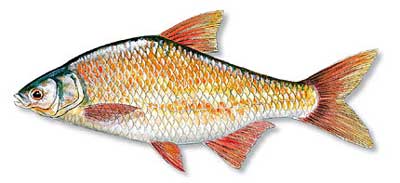Catching Shiners
Catching Shiners
Shiner fishing for trophy bass is one of the sport's most exciting and effective techniques. According to top Florida guides, at least 90 percent of the state's 10-pounders are taken on these frisky livebaits.
The golden shiner is the primary forage of largemouth in Florida and in many parts of the continent. These baitfish inhabit a huge range from central Manitoba, throughout the East Coast and west to Texas. They've also been introduced as far west as California. Wherever they're found in good numbers big bass will target shiners, selecting them over crayfish, shad, bluegills, or other common prey.

These large members of the minnow family commonly reach 10 inches and occasionally approach 12 inches and a pound in weight. Now that's a meal for a monster bass. Fishing with live shiners is fun, too. There's the fascination of fishing floats--watching marauding bass chase your baits to the surface, then watching the float descend before rearing back for a hookset.
Catching bait can also be a blast. In fact, guides often chuckle when they have to urge their clients to quit fishing for bait and start rigging for the big bass they've traveled to Florida to catch. Catching bait is fun, whether you're after golden shiners in Massachusetts or Florida, or goldeyes in Minnesota. Catching your own saves big bucks, as wild shiners typically cost around $14 a dozen. And you can expect to go through six-dozen in the course of a day, if the bite is on.
RIGGING TO CATCH SHINERS
Though large of body, shiners have tiny mouths, so appropriate hooks are in the #10 to #14 range. Treble hooks hold bait on the hook well, and their small barbs don't injure valuable baits. Golden shiners have an opportunistic diet, taking zooplankton, larval insects, fragments of plants, and filamentous algae that often grows on plants or rocks. Occasionally, they eat small minnows.
Chumming with oatmeal, casting the flakes over shallow, weedy flats will bring schools of shiners into the area and get them feeding. Then, impaling several oatmeal flakes on a tiny hook, or balling bread around the tines of the treble hook is the basis of shiner fishing. One or two tiny split shot complete the rig. Small pieces of earthworm work, too. Shiners can also be caught on tiny marabou crappie jigs, in the 1/32-ounce range.
When a good school is assembled and rolling the surface as they feed, a long fiberglass or cane pole is the most effective setup. Lower your bait, holding it near the surface until a shiner bites, then unceremoniously hoist it in. Carefully unhook your shiner, holding it firmly but without squeezing, then place it in your aerated or oxygenated shiner tank.
For maximum fun, try true ultralight tackle for shiner fishing (or should we say catching). A 4-1/2- to 5-1/2-foot limber rod and micro reel spooled with 2-pound test means a battle from bigger shiners. At times, too, the weblike line will get more bites than the 10-pound mono usually used on poles.
If you're eager to hook a big bass, catching shiners with a cast net is easier and more efficient (if you know how to throw a net). If you want a laugh, hand a novice a cast net and observe the action.
After catching your shiners, it's best to condition them before using them to catch bass. Additives are available that quickly relieve stress and keep shiners frisky. Large round tanks with bottled oxygen systems are the best way to keep shiners long-term. In the boat, a large cooler with an aerator works well for a day's fishing. In summer, regularly adding a small amount of ice helps keep shiners fresh.
|